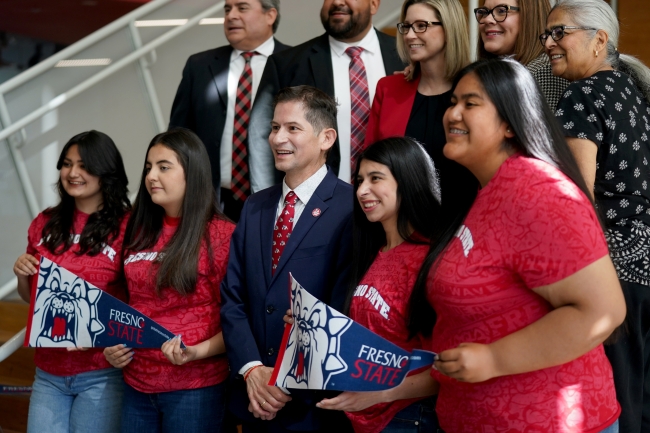You have /5 articles left.
Sign up for a free account or log in.

Local high school students from partner districts in Fresno State’s Bulldog Bound initiative pose with university president Saúl Jiménez-Sandoval at the program launch event last May.
Cary Edmonson/California State University, Fresno
Felix Cazares is only in the ninth grade, but he’s already been accepted to a four-year college. He has the university ID, student email address and admission letter to prove it.
The offer came from California State University, Fresno, which launched an early guaranteed admission program this fall called Bulldog Bound. The institution is partnering with regional K-12 districts to guarantee admission to students as soon as they enter high school, which will hopefully set them on a clear-cut path toward postsecondary education.
Acceptance is conditional: Cazares must maintain at least a C average at his high school, Duncan Polytechnic in Fresno, and remain in good standing. And he is under no obligation to attend Fresno State once he graduates. But the program is immersive; participants receive access to the campus libraries and college counseling resources. Come summer, they will also be able to take noncredit courses in disciplines that interest them. By 11th grade, eligible students receive formal early admission and an estimate of their financial aid package.
For Cazares and other students in California’s largely rural, comparatively undereducated Central Valley, Bulldog Bound offers major encouragement to stay on track academically and a promise that there’s a place for them after graduation.
“This program has definitely changed my view on college,” Cazares said. “To know that if I work hard, at the end of four years, they will take me … it’s already getting me excited.”
So far the Bulldog Bound program has partnered with 29 school districts—including the state’s third largest, Fresno Unified—and 4,031 individual students have signed up, according to a university spokesperson.
Direct and guaranteed admission initiatives have gained popularity around the country in recent years. They saw a spike in interest after the Supreme Court struck down affirmative action last summer, thanks to their successful record of improving college access for underrepresented groups. But most programs don’t contact students until their junior or senior year of high school.
Mary Churchill, director of the higher education administration program at Boston University (and an opinion contributor to Inside Higher Ed), said starting earlier is both smart and increasingly necessary.
“Everyone is digging down deeper in their pipelines,” she said. “Research shows that a student’s college-going identity—whether they see themselves going or not, what kind of institution they see themselves at—begins forming in seventh and eighth grade. For students who might not otherwise plan on going to college, or where it’s not a family expectation, starting early is a fantastic idea.”
Bulldog Bound also offers resources for parents, including financial aid information sessions. Claudia Cazares, Felix’s mother, said that aspect has set Fresno State apart. She has two older children, neither of whom are enrolled in college; she wishes they’d had Bulldog Bound to open their eyes to their own potential, she said.
“Our district has a lot of kids like Felix who aren’t straight-A students, who struggle to get Bs and Cs, so the stress this puts on staying on track is a big deal,” she said. “We’ve lived right down the road from Fresno State for 23 years, but kids here hardly ever think about it as an option … This program, I believe, will change that.”
Bulldog Bound is still in its first year, so there’s no data on how it will translate to enrollments. But early signs are promising: Fresno State president Saúl Jiménez-Sandoval cited a “dramatic increase” in prospective students from participating high schools this cycle—mostly seniors who were informed of the program in the fall—resulting in 1,759 Bulldog Bound applicants.
The biggest influx has come from rural school districts that don’t normally send many graduates to four-year colleges, Jiménez-Sandoval said. Applications to Fresno State increased by 60 percent from Kings Canyon Unified, in the mountainous Orange Cove region, and 43 percent from Dinuba Unified, where over 30 percent of the population live in poverty.
Jiménez-Sandoval said his “modest” goal is for 80 percent of Bulldog Bound students to matriculate to Fresno State. He has good reason to aim high: last summer the CSU system announced penalties for colleges that see year-over-year enrollment declines, and Fresno State’s full-time head count has decreased for the past two years in a row. But Jiménez-Sandoval said the program was equally driven by a sense of community service.
“Starting this path of knowledge leads to a sense of self-worth, which we hope leads to a sense of belonging here at Fresno State,” he said. “Knowing early on what it takes to get here, and having faces and names connected to professors and counselors, makes the idea of college, which can often feel indifferent and strange, less distant. It puts it in reach.”
Uplifting California’s Other Valley
The San Joaquin Valley, Fresno State’s home turf, is one of the most rural areas in California. It’s also incredibly diverse: 54 percent of its residents are Latino or Hispanic, and it boasts the largest Hmong immigrant population in the U.S., mostly refugees from Laos’s so-called secret war who immigrated in the 1970s and ’80s. Excluding Sacramentans, one in five of the valley’s residents live in poverty; the statewide average is 13 percent, according to the Public Policy Institute of California.
Those factors combine to make college a distant concern for many families, especially first-generation immigrants. Only about 53 percent of high school graduates in the San Joaquin Valley go on to seek a postsecondary degree, compared to more than 70 percent in Southern California and the Bay Area, according to the Public Policy Institute.
Bob Nelson, superintendent of the Fresno Unified School District, the Bulldog Bound program’s first official partner, said plentiful jobs in agriculture and a growing shipping industry led by a burst of Amazon warehouses—neither of which requires a college education for employment—make it difficult to convince local families of the value of a four-year degree.
“Fresno is very different from other areas of California,” he said. “We’re a community that deals with bone-crushing intergenerational poverty and a lot of distrust in public institutions … College isn’t usually a priority here.”
Jiménez-Sandoval wants to change that. Beyond meeting Fresno State’s enrollment goals, he hopes the Bulldog Bound program can be a first step in building a “culture of college-going” in the valley.
“Fifty percent of A-G eligible students here don’t attend college,” he said, referring to the statewide 2.5 GPA requirement for admission to University of California or CSU campuses. “That’s the population we want to target.”
A Spirit of Collaboration
Churchill said Fresno State’s program combines some of the cutting-edge outreach practices many enrollment management offices are deploying right now. The difference is that while other direct or guaranteed admission programs treat the offer itself as its own attraction, Bulldog Bound is built on the theory that getting students to campus takes frequent engagement.
“A lot of these strategies are basically recruitment marketing tools, a lot like the PSAT, where the goal is essentially to get a lot of data that colleges can use, but instead of sending a brochure you send an acceptance letter. There’s not much engagement or individualization there,” she said. “I have seen programs where they’re bringing students to campus, that kind of thing, but not in ninth grade. This really puts together a lot of pieces I think work well in other programs in a nice new package.”
That could make Bulldog Bound an asset for student success as well, she said, helping Fresno State officials understand and prepare for the issues current high schoolers may face when they arrive—a task that has become more challenging since the pandemic destabilized students’ early learning years and exacerbated an array of mental health issues.
Churchill has a few concerns about starting so early—namely that students might feel “locked in” to the college, despite the nonbinding agreement, and not bother to look at other institutions that could be a better fit or more affordable. She also noted that ninth graders are vastly different developmentally from 11th and 12th graders, and she emphasized the importance of not treating them “like young college students.”
Nelson, of Fresno Unified, believes Fresno State has done a lot to assuage those concerns, including getting himself and other K-12 administrators directly involved.
“We’re talking all the time, so there’s less of this disconnect that can often be there between the 20,000-foot, largely theoretical view of higher ed and the ground-level realities we deal with,” he said. “You need someone working closely on an initiative like this who speaks K-12 natively.”
For Churchill, that collaborative spirit is the most exciting part of Bulldog Bound. Whatever this spring’s matriculation rates show, she hopes more colleges and statewide systems will follow Fresno State’s playbook and work closely with regional school districts.
“These kinds of programs really demystify higher education and blend the two worlds,” Churchill said. “That’s the kind of education ecosystem our country needs right now.”





